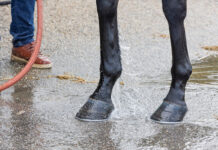Equine feed companies are required by law to include specific information on their complete feed and supplement labels: The name of the feed, the class of horse the feed is designed for (broodmare, growing horse, et cetera), ingredient list and “guaranteed analysis” are all required information, says Karen Davison, Ph.D., manager of technical support for Land o Lakes Purina Feed.

But interpreting a feed tag label, particularly the “guaranteed analysis” information, is difficult. The guaranteed analysis label gives consumers the feed’s basic nutritional values, including guaranteed percentages of certain nutrients. But according to Davison, what is required on the label are only those nutrients that regulators deem the most important nutrients for that species.
In the United States, animal food, including horse feed, is regulated by the Food and Drug Administration and by individual states. Inspections at manufacturer sites by regulatory officials ensure that the feed in the bag matches what’s on its label.
Feed Label Requirements
Nutritional values that must be listed by law in the guaranteed analysis are the minimum percentages of crude protein and crude fat, and the maximum percentage of crude fiber. Feeds that contain more than 6.5 percent total mineral elements must also include the minimum and maximum percentage of calcium; minimum percentage of phosphorus; minimums of copper, selenium, zinc and vitamin A.
What about the mandatory nutritional values on the guaranteed analysis label?
Crude protein: You might see a feed label that guarantees crude protein is “not less than 10 percent.” But since the maximum percentage of crude protein is not required by law to be listed on the label, how do you know what the high end is? According to Davison, if it isn’t listed, the percentage can get as high as the manufacturer wants it to.
What about the calcium to phosphorus ratio, which is so important in your horse’s diet? Why do regulatory agencies require both minimum and maximum levels of calcium, but only minimum levels for phosphorus?
“Calcium is relatively inexpensive. Years ago you’d find manufacturers putting in large amounts of calcium to make the product less expensive to manufacture, so regulators put a maximum on calcium,” Davison explains.
“Phosphorus, on the other hand, is a relatively expensive nutrient. Since there would be no benefit to putting in higher than guaranteed amounts, it’s likely the percentage isn’t higher than the guarantee,” Davison continues. This same “logic” applies to additional costly feed components, such as other minerals, crude protein and fat.
On the flipside, there’s fiber. Historically, fiber was “filler” and a very inexpensive feed ingredient. Higher fiber meant cheaper and lower calorie, so regulators placed a guaranteed maximum on crude fiber. However, in recent years with the use of more digestible fiber sources like beet pulp and soy hulls, higher fiber doesn’t always mean cheaper or lower calorie.
You won’t find a minimum percentage of fiber on most guaranteed analysis tags. “Fiber is required to be listed with a maximum percentage only,” Davison says. But can the fiber level fall far below the guaranteed maximum percentage? Yes, Davison says it’s possible.
Davison’s advice to horse owners who are looking for the most reliable feed for their animals is, “Look to a reputable company. Feed tag labels help narrow your choices, but don’t give you the entire picture.”
For more information on reading feed tags, visit the Association of American Feed Control Officials at www.aafco.org.







very interesting article.
Good information provided here. Helps to pick out what is best for our beloved furry friends.
Quote: “Since there would be no benefit to putting in higher than guaranteed amounts, it’s likely the percentage isn’t higher than the guarantee”
This statement is misleading because it assumes that everything in the feed is an “added ingredient” The truth is they don’t account for what comes naturally in the grains.
Grains have mineral content, high or low, depending on the soil it is grown in. The feed companies use “book values” for calculating the mineral and vitamin content. The book values assume that all grains of the same species have the same mineral content. Their “book values” are totally outdated (40 years old)because they were written when grains were only grown in a few midwestern states with low selenium soils.
I have found out that most of our grains are now coming from South Dakota and Nebraska (toxically high Selenium soils) and being shipped everywhere because they are cheaper. Recent test results show the Selenium content of these grains are toxically high and will make your animals have hoof problems at the very least, and the rest of the symptoms can cause everything from agressive behavior, diabetes, liver problems, etc.. the list is a mile long.
The feed companies have no idea the real selenium content of their feeds because they don’t test for it. They are hoping you don’t figure it out. Then on top of that they are adding more selenium. They add the maximum allowed by law with no regard to what is already in the grains or what each age or species of animal may require.
Animals grazing in high selenium soils get selenium toxicity all the time. But those of us with no experience with selenium wouldn’t think that cracked hooves or laminitis is related to reproductive problems. The truth is they can be related, your animal may only have one symptom or many symptoms, it all depends on where the selenium decides to come out.
Last year I lost 100 sows due to feet and leg problems due to the selenium content of the grains from LOL/Purina feed.
Check out this brochure, just take out the word “pork” and put in “horse” you will get the picture. This is a recent brochure put out at the request of the National Pork Board because of what myself and other animal owners have discovered. Now I want to get the word out to more people.
http://www.pork.org/documents/porkscience/selenium%20toxicity.pdf
You can contact me for more information.
qbarfarm@viclink.com
Good information